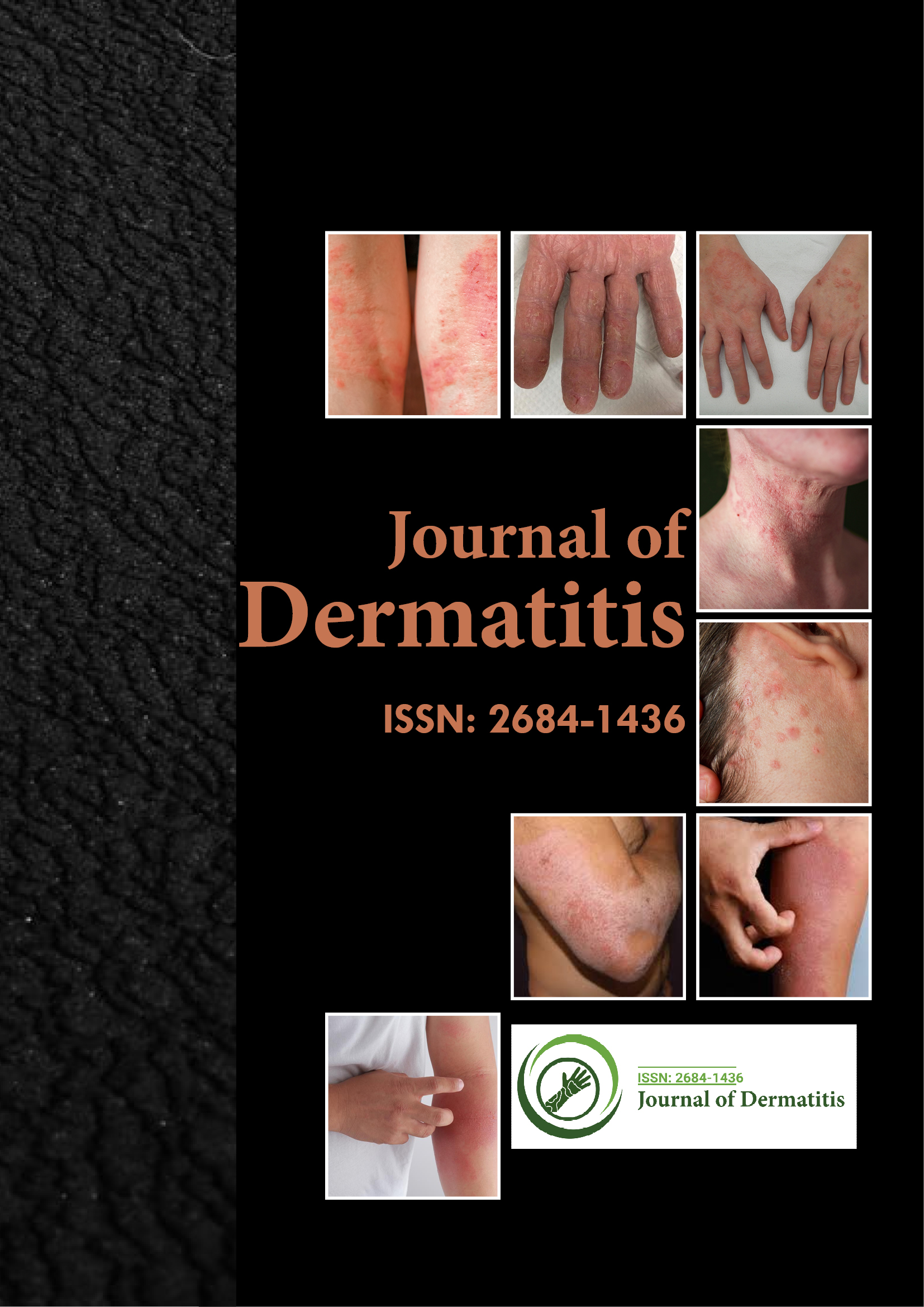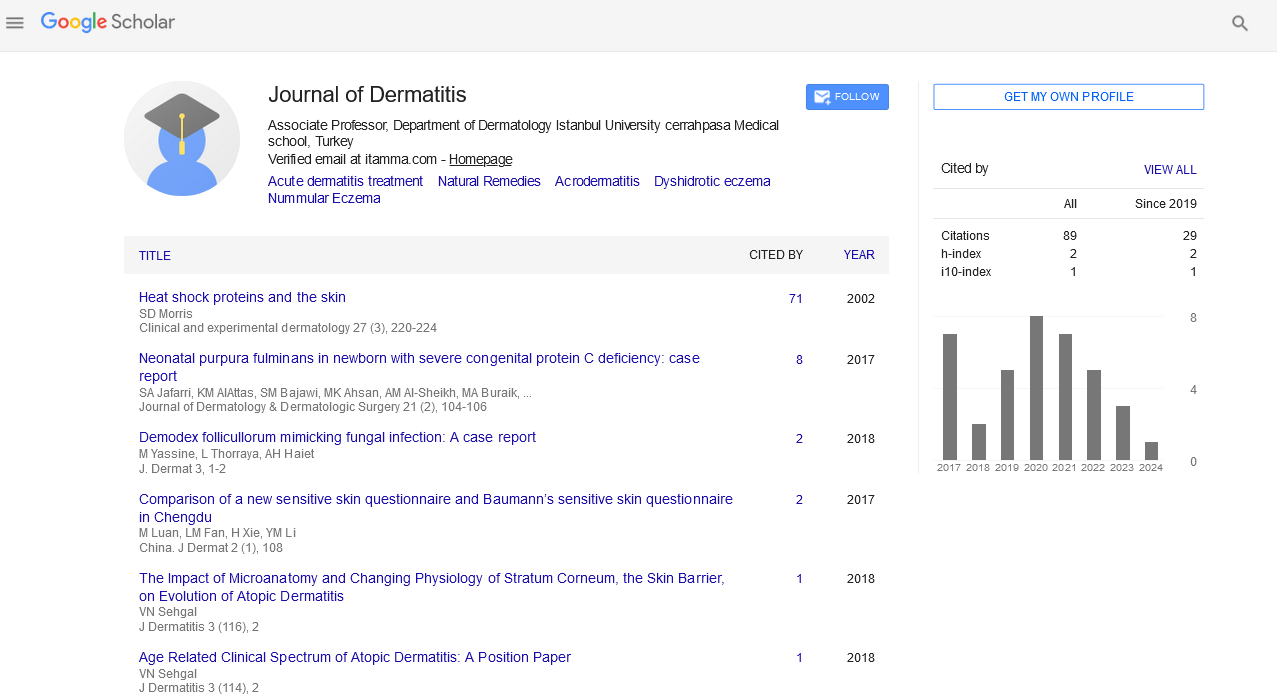Indexed In
- RefSeek
- Hamdard University
- EBSCO A-Z
- Euro Pub
- Google Scholar
Useful Links
Share This Page
Journal Flyer

Open Access Journals
- Agri and Aquaculture
- Biochemistry
- Bioinformatics & Systems Biology
- Business & Management
- Chemistry
- Clinical Sciences
- Engineering
- Food & Nutrition
- General Science
- Genetics & Molecular Biology
- Immunology & Microbiology
- Medical Sciences
- Neuroscience & Psychology
- Nursing & Health Care
- Pharmaceutical Sciences
Opinion - (2025) Volume 10, Issue 1
Systemic Biomarkers of Gut Dysbiosis and Metabolism in Vitiligo Patients
Kerstin Schlund*Received: 25-Feb-2025, Manuscript No. JOD-25-29128; Editor assigned: 27-Feb-2025, Pre QC No. JOD-25-29128 (PQ); Reviewed: 13-Mar-2025, QC No. JOD-25-29128; Revised: 20-Mar-2025, Manuscript No. JOD-25-29128 (R); Published: 27-Mar-2025, DOI: 10.35248/2684-1436.25.10.268
Description
Vitiligo affects approximately 0.5-2% of the global population and presents as acquired depigmentation of the skin due to selective loss of melanocytes. While its etiology involves autoimmunity, oxidative stress and genetic predisposition, a growing body of evidence suggests that systemic interactions particularly involving the gut microbiome and mental health play important roles in disease onset and progression.
Patients with vitiligo frequently experience emotional distress, including anxiety, low self-esteem and depression. These psychological states are not only outcomes of the disease's visible nature but may also contribute to systemic inflammation and immune dysregulation. Recent studies propose that emotional health, microbiota composition, and metabolic processes may be interconnected in vitiligo pathophysiology.
Gut-skin axis in autoimmune conditions
The gut-skin axis refers to the bidirectional communication between intestinal microbiota and skin health, mediated by immune signals, metabolites and the nervous system. In autoimmune and inflammatory skin diseases, such as psoriasis and atopic dermatitis, alterations in gut microbiota have been well documented.
In vitiligo, this connection is under active investigation. Disruptions in microbial diversity and changes in the abundance of specific bacterial taxa have been identified in affected individuals. These imbalances can alter gut permeability, immune cell priming, and cytokine profiles, all of which may influence melanocyte-targeted autoimmunity.
Microbiome alterations in vitiligo
Studies exploring gut microbial profiles in vitiligo patients have reported several consistent features.
Reduced alpha diversity: Alpha diversity reflects the number and evenness of microbial species in the gut. Vitiligo patients often show lower alpha diversity, indicating a less balanced microbial ecosystem.
Increased firmicutes-to-bacteroidetes ratio: This altered ratio is frequently observed in autoimmune diseases and may reflect metabolic and immunological imbalances.
Decreased abundance of beneficial bacteria: Bacteria such as Faecalibacterium prausnitzii, known for producing anti-inflammatory Short-Chain Fatty Acids (SCFAs), are found in lower numbers in vitiligo patients.
Elevated pathobionts: Overrepresentation of potentially inflammatory bacteria, including Escherichia coli and Ruminococcus gnavus, has been documented.
These changes may influence immune tolerance and barrier integrity, predisposing individuals to autoimmune activity against melanocytes.
Emotional distress and microbial dysregulation
Mental health and the gut microbiome are linked through the microbiota–gut–brain axis. Emotional distress can influence gut function, motility, secretion and microbial composition through both neural and hormonal pathways. Conversely, microbial imbalances can affect mood and behavior by altering neurotransmitter synthesis, modulating the Hypothalamic–Pituitary–Adrenal (HPA) axis and stimulating systemic inflammation.
Metabolic signatures in vitiligo
Beyond microbiota, the metabolic profile or metabolome of vitiligo patients is also altered. These metabolic shifts reflect immune activation, oxidative stress and mitochondrial dysfunction. Commonly reported metabolic features include.
Elevated homocysteine levels: Hyperhomocysteinemia has been reported in several studies on vitiligo and may impair melanocyte survival through oxidative stress and DNA damage.
Impaired tryptophan metabolism: Tryptophan metabolites are precursors for serotonin and kynurenine pathways. Disruptions in these pathways have been linked to both skin inflammation and mood disorders.
Changes in lipid profiles: Abnormalities in fatty acid metabolism, including reduced omega-3 levels and increased lipid peroxidation products, are observed in vitiligo patients, especially those with more extensive disease.
Vitiligo is increasingly recognized as a systemic condition influenced by more than cutaneous immunity alone. The interaction between gut microbiota, metabolic processes, and emotional health creates a complex landscape that may influence disease onset, severity and progression. Patients with co-morbid emotional distress show distinct patterns in both microbial composition and metabolic function, suggesting an interconnected pathway of immune and neuroendocrine dysregulation. Recognizing and addressing these factors may open opportunities for more comprehensive vitiligo management and improved patient outcomes.
Citation: Schlund K (2025). Systemic Biomarkers of Gut Dysbiosis and Metabolism in Vitiligo Patients. J Dermatitis. 10:268.
Copyright: © 2025 Schlund K. This is an open-access article distributed under the terms of the Creative Commons Attribution License, which permits unrestricted use, distribution, and reproduction in any medium, provided the original author and source are credited.

